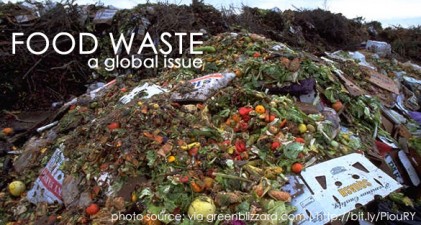We throw away nearly $800 billion worth of food each year

By Dr Anthony Horton
With the Christmas and New Year holidays now well behind us, many people are probably thinking about resolutions for the year ahead. If you are still stuck for ideas, recently published figures from the Food and Agriculture Organisation of the United Nations (FAO) may help. They estimate that globally, food worth approximately US$750 billion is either lost or wasted each year. This staggering amount is even more astounding when you consider that food production reportedly consumes approximately 25% of all water used in agriculture worldwide, and requires a cropland area the size of Mexico. As if that isn’t bad enough, wasting that food is responsible for 3.3 billion tonnes of greenhouse gas (GHG) emissions each year. These emissions result from food that is produced but not eaten.
These figures and findings have been published in the Land Use chapter of ‘The New Climate Economy Report 2016’. The chapter begins with a discussion on the changing reality of agriculture and forestry around the world. This reality includes factors such as population growth, resource scarcity, and the need to mitigate and adapt to climate change. Supply-side strategies to increase agricultural productivity through new technologies are also reviewed; along with an analysis of demand-side measures that reduce pressure on natural resources, including ways to minimise food loss and waste. The natural capital of forests, trends in deforestation, forest degradation, and ways to scale up positive change are all discussed in this Land Use chapter which concludes with a series of recommendations.
The chapter does not pull any punches in the six main points covered. The year 2030 is used as a date by which a number of outcomes are to be achieved on the basis that the world’s population is expected to grow by 1.2 billion people and the middle class is expected to double by then. Its first is that rapid population growth and urbanisation are among the factors crucial to food security and livelihoods. Therefore, the chapter strongly urges decision makers to make agriculture a top priority for economic and environmental policies, particularly in developing countries. The second main point is agricultural productivity must increase to keep up with food demand-through addressing drought, resistance to pests and salt and increasing R+D funds.
Thirdly, the chapter calls for policy interventions to facilitate the adoption of new technologies and practices among small landholders. At a Government level, climate change adaptation finance, agricultural insurance schemes, and more secure property rights are examples of the interventions that should be considered. New approaches to farming are also required to maintain the integrity of ecosystem services and to overcome market failures.
One quarter of the world’s food on a caloric basis is lost or wasted between the farm and the fork
The fourth main point of the chapter is that one quarter of the world’s food on a caloric basis is lost or wasted between the farm and the fork – this means one out of every four food calories intended for human consumption is ultimately not consumed. To counteract this, demand-side measures are needed to address the negative environmental and economic impacts of such wasteful expenditure. Fifth, waste reduction measures in developed countries could save $US200 billion, and reduce GHG emissions by 0.3 Gigatonnes each year. According to the report, policy makers should also work to reduce the demand for food crops as biofuels, and to promote a dietary shift away from red meat. Red meat production requires nearly 30 times the amount of land required by chicken or pork, consumes more than 10 times the amount of water and results in five times the amount of greenhouse gas emissions of chicken or pork.
The chapter also discusses a number of other outcomes to be achieved by 2030. The ongoing deforestation and degradation of forests (especially tropical forests which are cleared more extensively than others) needs to be prevented when promoting increased agricultural productivity which is required to keep up with food demand. Achieving net zero deforestation (defined as the clearance of forests in one area and the replanting of an equal area somewhere else) could reduce GHG emissions by approximately 3 Gigatonnes each year. The sixth main point of the chapter states that restoring 12% of the worlds degraded agricultural land could increase the income of small landholders globally by US$35-40 billion and provide sufficient food for 200 million people each year. It could also increase resilience to weather shocks and reduce GHG emissions by approximately 2 Gigatonnes each year. Restoring a minimum of 250 million hectares of forest could generate US$170 billion in watershed protection benefits.
The Land Use chapter concludes with recommendations covering three themes on a global scale:
- Enhancing agricultural productivity and climate change resilience in developing countries
- Managing demand for agricultural products
- Eliminating deforestation, and restoring degraded forests
The statistics presented in this report are staggering. Wasting nearly $800 billion dollars worth of food on a global scale every year is clearly a very serious environmental and social issue for everyone. It transcends the debate of whether developed or developing nations should take the lead, as all of us need to play our part regardless of which country we live in or our economic status. Research published in a number of leading journals (some of which I have written articles on previously) is already telling us that some food crops including wheat, rice, maize and coffee are becoming increasingly vulnerable to changing environmental conditions around the world (e.g. lower rainfall, shorter growing seasons, soil erosion). These environmental changes need to be better understood and researched in order to increase the resilience of food crops to climate change. If we don’t gain a better understanding of the influence of a changing climate on food production, food security will be threatened which will increase the purchase price of that food, potentially put it out of the reach of the poor around the world. The ultimate irony of producing but not consuming nearly $800 billion worth of food on a global scale each year is that doing so releases huge quantities of greenhouse gases into the atmosphere which in turn fuels changes in climate that threaten the growth of the food on which we rely for our basic survival. This is a vicious and tragic cycle indeed. It is clear that if climate change is going to change the amount of food that can be grown each year, we will need to change our behaviour and ensure that as much as possible of the food produced around the world is consumed.
 About the author: Anthony Horton holds a PhD in Environmental Science, a Bachelor of Environmental Science with Honours and a Diploma of Carbon Management. He has a track record of delivering customised solutions in Academia, Government, the Mining Industry and Consulting based on the latest wisdom and his scientific background and experience in Climate/Atmospheric Science and Air Quality. Anthony’s work has been published in internationally recognised scientific journals and presented at international and national conferences, and he is currently on the Editorial Board of the Journal Nature Environment and Pollution Technology. Anthony also blogs on his own site, The Climate Change Guy.
About the author: Anthony Horton holds a PhD in Environmental Science, a Bachelor of Environmental Science with Honours and a Diploma of Carbon Management. He has a track record of delivering customised solutions in Academia, Government, the Mining Industry and Consulting based on the latest wisdom and his scientific background and experience in Climate/Atmospheric Science and Air Quality. Anthony’s work has been published in internationally recognised scientific journals and presented at international and national conferences, and he is currently on the Editorial Board of the Journal Nature Environment and Pollution Technology. Anthony also blogs on his own site, The Climate Change Guy.









2 comments
Login here Register here-
RosemaryJ36 -
townsvilleblog
Return to home pageAnd our climate change scientists at CSIRO are all going!
and homeless people and pensioners are short of food, charity begins at home. Surely someone can organize a collection at the end of the day of restaurants not eaten but cooked food to share with especially the homeless people. We like to think of ourselves as a prosperous nation however we need not look far to see those who are a lot worse off than ourselves.